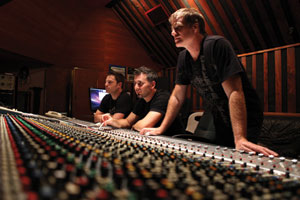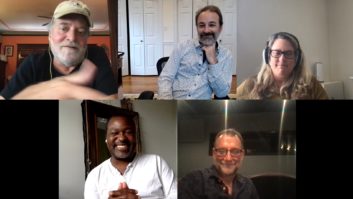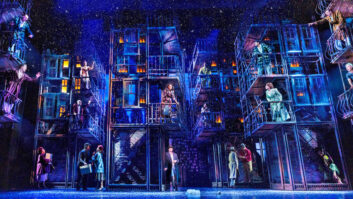
Ari Winters, Neil Goldberg, and Dave Fraser
In a previous life, Neil Goldberg, a founding member of Heavy Melody Music, was a guitarist with the cult metal band Annihilator who once turned down Sharon Osbourne when she offered him an audition for Ozzy’s band. The time wasn’t right.
In another previous life, Goldberg was a staff composer for Sunday Productions, a jingle house that was a staple in the Manhattan advertising community for decades. There, along with business and composing partner Dave Fraser, he wrote music for a number of Gillette Super Bowl spots as well as ad music for GE, The NFL, Sony, AT&T and others.
Today, he and Fraser, along with two other staff composers/sound designers, produce tracks for movie trailers and video games under the moniker Heavy Melody Music, while also developing virtual instrument libraries under the name Heavyocity. So we’ll start with the obvious: How does one square producing commercial music with the image of a beast, armed with a six-string hammer and a warrior mentality?
“That’s a good question!” says Goldberg, who grew up in Massachusetts, the son of two social workers, before heading off to nearby Berklee College of Music. “My days of touring with a speed-metal band ended many years ago, but I still love crunchy guitar. Film and game soundtracks and electronic music also attract me. The emotion of contemporary film-trailer music is a perfect outlet for us to combine the many styles that influence us in unique ways. We like to mix in sound-design elements for the tracks we release. With both Heavyocity and Heavy Melody, we take a ‘music-meets-sound-design’ approach.”
Heavy Melody Music, located on 7th Avenue, just below midtown Manhattan, is home to four composers, all of whom mix the tracks they write and produce, often with input from their colleagues. Co-founder Fraser met Goldberg when both were Berklee students. He is, according to Goldberg, the one who decided that Heavy Melody Music should expand into the virtual instrument library field.
Composer/sound designer Ari Winters has been a core member of the team for years, with work featured on motion picture and game trailers, including Zero Dark Thirty and Dead Space 3. The fourth and newest member of the team, composer/sound designer George Valavanis, is also a DJ and record producer; many of his songs have been released on KD Music, Suara, Buddha Bar and other labels.
Mix spoke to Goldberg about his writing and the libraries that Heavyocity designs.
How are the Heavy Melody Music studios laid out?
“We have four composing/studio rooms, two of which share a live room. I have a small room off of my studio where I record my guitar work. Digital Performer 8 is my workstation—I know that DAW inside and out, so I don’t have to think about anything when I fire it up.”
Do you use any of DP’s internal instruments or effects?
“Not too much. I have lots of third-party instruments—I love iZotope, for example, and have most of their stuff. I also use a number of plug-ins from Waves, PSP and SoundToys, and I have two UAD cards. Their stuff is modeled extremely well.
“I’m running a pair of 8-core Mac Pros and a 12-core Mac Pro. All of them have 32 gigs of RAM. Genelec 8040s are main monitors, and I have a Focal CMS subwoofer. For video output, I use an Apple 27-inch monitor on my main machine. I also run an HP 27-inch video monitor that can switch between that Mac and one of my slaves. The second slave has a Dell 23-inch monitor on permanent assignment. Both slaves run Vienna Symphonic Library’s VE Pro and a number of other virtual instruments.”
The AEON virtual instruments include quite a few filtering and EQ features. How would you compare the signal processing that you use when you’re recording and editing a sample library with the tools available to the end user inside the software?
“That’s an interesting question. Our initial goal is to capture the sound using great outboard equipment. Then we bring the material into the DAW for editing. We’re not shy when it comes to using plug-ins to alter and improve audio—our sounds can be aggressive. I have a decent amount of outboard gear, including a pair of Neve 33122 broadcast mic pre/equalizers that I love. They blow up nicely; they can be clean, but you can overdrive them and get a very cool saturated sound.
“I also have a pair of Wunder Audio mic pre/EQs, model PEQ1R. They’re kind of like the classic Neve 1073—great for recording guitar, bass and drums. They’re not super quiet, but they’re meaty. Being a guitarist, I can’t help but love them! When we need an über-clean signal path we’ll pull out our Grace Audio M201 stereo mic pre. It’s great for recording quiet material that needs a low noise floor. We also rely on the Universal Audio 2-1176 stereo unit.
“Like I said, goal number one is to capture the sounds perfectly. Then we work on developing them inside the workstation. We’re all composers first, and our library work grew out of our production experience. We’re always looking for new sounds that will capture the listener’s ear.
“It’s also important that our products offer sound-sculpting tools that let the user morph the material we present and make sounds that have an individual character. We use the FX filters and EQ capabilities within Kontakt 5, our release platform, which we customize quite deeply. As for EQ and roll-off, if you’re looking to put a master EQ on the presets, there are probably a dozen third-party manufacturers that have plug-ins that will do the job equally well, and that includes your DAW.
“But sure, when you’re getting deeper into the details, looking to add punch to a sound, some tools will be better than others. We believe that the work we do, plus the tools that we build into the instruments, like our signature ‘Punish Knob,’ give the user a great set of sounds and the ability to further tailor them.”
Do you use outboard faders or mix inside the box?
“I have a Euphonix MC Mix that’s a few years old; Avid owns them now. It’s a cool unit, but I end up mouse mixing most of the time.”
What’s your go-to reverb?
“I use Altiverb. I own the Waves IR-1 ‘verb, but prefer Altiverb. I like its features and layout, and their Impulse Responses are excellent.”
Anything else on the hardware side that you lean on?
“My old Berklee roommate John Ellis has a company called Dramastic Audio. They make a stereo bus compressor, Obsidian, that glues a mix together really well—it’s similar to the SSL bus compressor. I use it all the time. I’m also a Dangerous Audio fan. I have their D-Box, 2-bus LT and BAX EQ module.”
SIDEBAR
Checking Out the Library
In 2004 Dave Fraser came up with the concept of aggressive, unusual-sounding sample libraries, which worked its way into EVOLVE, Heavyocity’s first library. The company’s two newest libraries, AEON Rhythmic and Melodic, were released earlier this year.
Rhythmic and Melodic share similar-looking skins and many common features. Plenty of presets are offered for both. They’re universally excellent, but watch out: if you rely too heavily on them, you could sacrifice your individuality. The arpeggiation presets in particular are extremely attractive—they sound great but have a powerful gravitational pull. Instead of building tracks around them, start out with Melodic’s Aeon Hits or Rhythmic’s Single Loops and dive under the hood.
The composers at Heavyocity used ReCycle during their surgical procedures. If you’re looking to customize a Rhythmic loop, a good place to start is the Advanced Loop page. All REX files are laid out as slices on the keyboard and in the display. Experimenting with tuning, panning, and the levels of individual slices can yield interesting results. The loops—aggressive to begin with—can punch harder or be toned down to taste by accenting or clamping down on the most radical sounds.
The effects package (Trigger FX) consists of Distortion, Lofi, Filter, Panner and Pitch Mod devices, and is identical in both instruments. The first page houses a simple set of controls for each effect, but if you want to dig deeper, the Advanced page gives access to step sequencers that let you customize the sounds further by auto-modulating the parameters. A very cool feature allows you to turn the five effects on and off in real time by invoking the keys F6-A6. The tippy-top keys, Bb6-C7, engage an Amp Sequencer; you’ll use it to modulate an instrument’s output at multiples of the original tempo, which is locked to your host. Set your DAW to 120 bpm, the rate of the amp sequencer to 16th notes, and press C7, which “pattern-gates” the output at 64th-note steps (this sounds complicated but isn’t). There you are…Stutter Step!
The Punish control beats the hell out sounds beautifully. The manual says that Punish is a “combination of compression and saturation controlled from a single knob.” You’ll be tempted to crank this one all the way up, but a more judicious application can yield pleasing results as well. Twist, “an animated, tone-altering effect,” does just that. Assign MIDI CC controllers to these two controls and you’ll taper the effects to taste as your track evolves.
The MIDI data that drives Melodic’s loops can be drag-and-dropped to your sequencer for further editing. These commands select slices for playing in the manner that Spectrasonics does with Stylus RMX. According to Goldberg, a Kontakt 5 limitation doesn’t allow for the transfer of Rhythmic’s arpeggiation information, which is a drag since the sequences these folks came up with are excellent. Of course, nothing prevents you from studying this material, setting your sequencer to a hard quantize value of 16th notes, say, and playing the identical patterns. You could then set all MIDI velocities to 64, lengths to 16th notes and edit to your heart’s content.
Sampled instruments fall into categories. Those that reproduce “real” instruments are short on sound-sculpting tools. Libraries that fall into the post-Buchla realm must balance ease of use with power. Heavyocity has done a great job in this regard.
Bottom line: AEON Rhythmic and Melodic are outstanding instruments and very reasonably priced.
AEON Rhythmic ($299); AEON Melodic ($199); Bundle price: $399. Purchased as downloads from www.heavyocity.com







